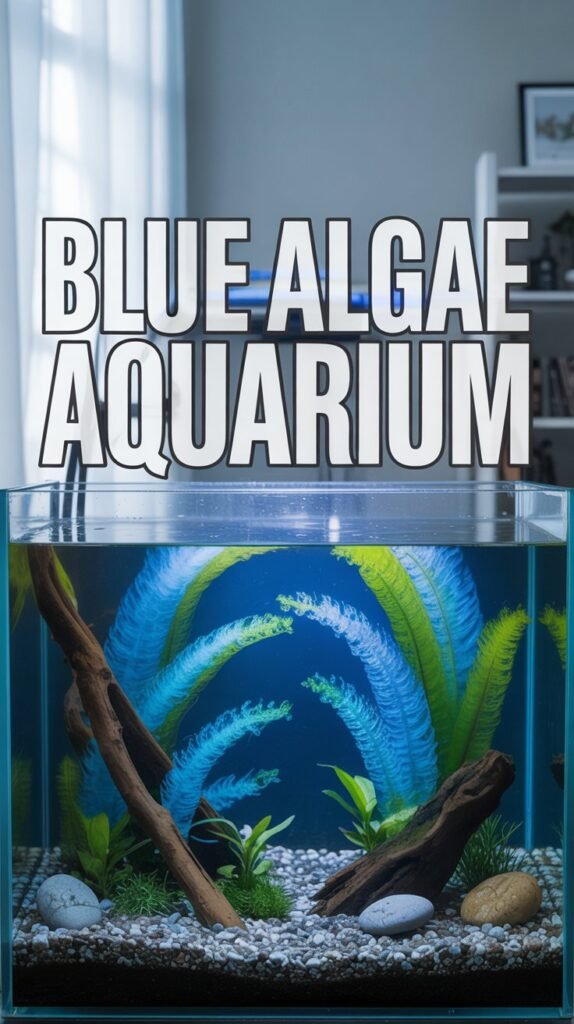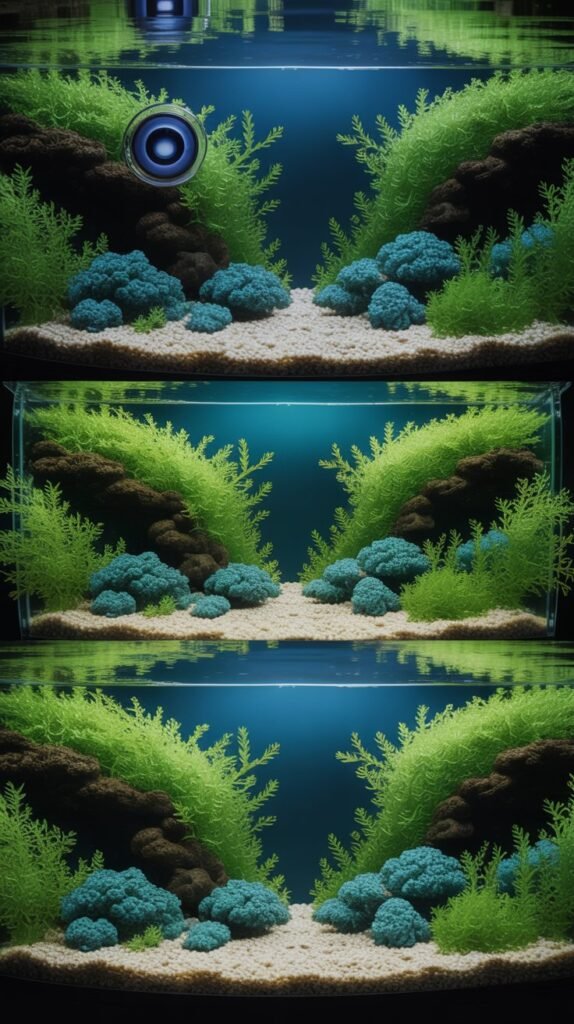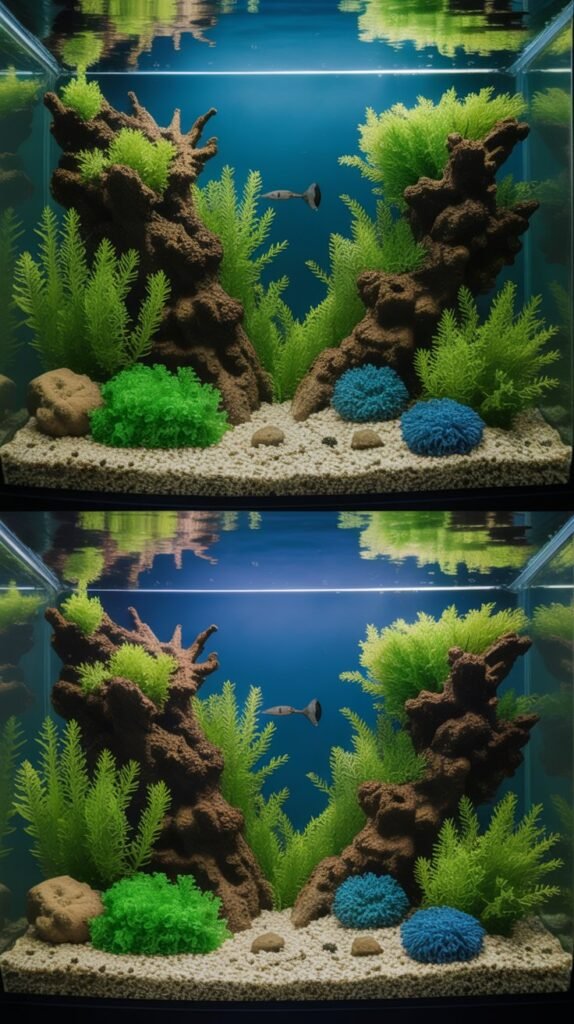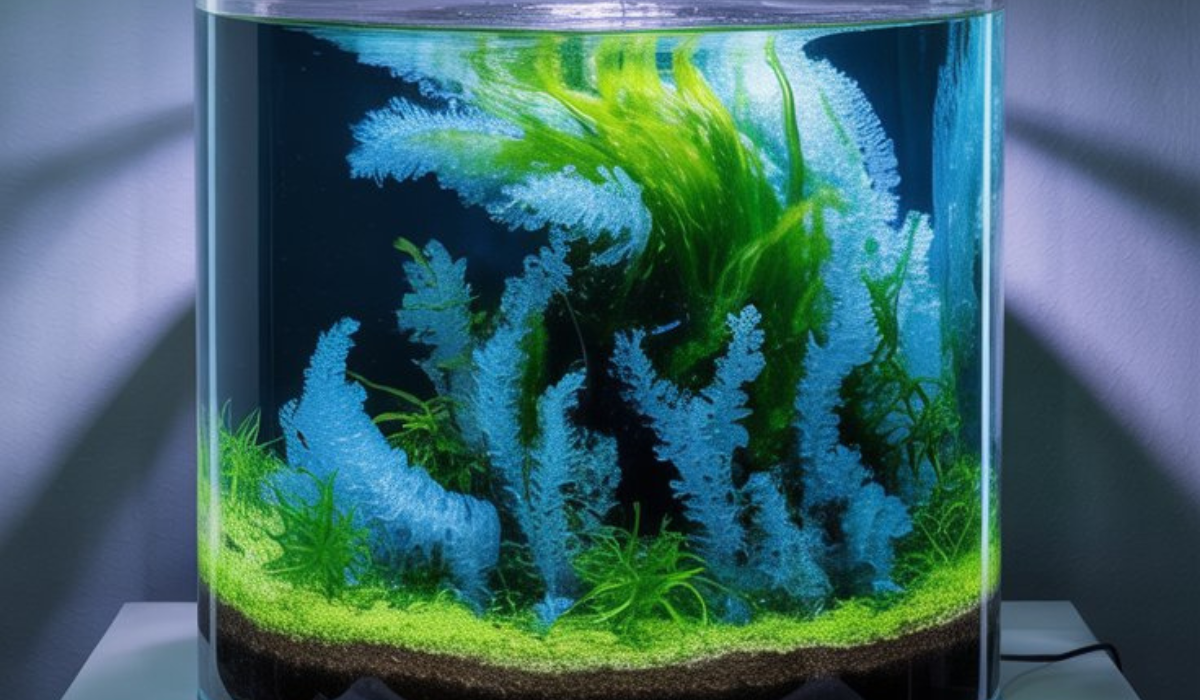Maintaining a clean, balanced aquarium is every aquarist’s goal. However, one of the most stubborn and frustrating problems many fishkeepers face is blue algae — a slimy, fast-spreading growth that can take over your tank almost overnight.
Although it’s commonly called blue-green algae, it’s not actually algae at all. It’s a type of bacteria known as cyanobacteria, and if not controlled, it can harm your fish, plants, and the entire aquarium ecosystem.
This complete guide will explain what blue algae really is, what causes it, how to remove it safely, and how to prevent it from returning — so your aquarium stays clean, healthy, and beautiful.
What Is Blue Algae (Cyanobacteria)?
Despite its name, blue algae isn’t true algae. It’s a photosynthetic bacteria called cyanobacteria that grows in water systems, soil, and even moist surfaces. In aquariums, it appears as a slimy film that ranges in color from dark green to blue-green, sometimes even reddish-brown or black.
It forms dense mats on aquarium glass, gravel, plants, and decorations, producing a foul odor similar to a swamp or stagnant water. Blue algae can grow extremely fast — doubling in size within hours — and can quickly take over the tank if left untreated.
Why Blue Algae Is Dangerous for Aquariums

Cyanobacteria not only make your aquarium look unattractive but can also harm its inhabitants and overall health.
1. Blocks Light
Blue algae cover surfaces, blocking essential light from reaching live plants. This prevents photosynthesis, causing plants to weaken and die.
2. Consumes Oxygen
At night, cyanobacteria consume large amounts of oxygen, depriving fish and beneficial bacteria, especially in poorly aerated tanks.
3. Releases Toxins
Certain strains of blue-green algae produce toxins (cyanotoxins) that can harm fish, shrimp, and snails if the outbreak becomes severe.
4. Rapid Spread
Once it appears, it spreads fast across glass, substrate, and decorations, smothering everything in its path.
Identifying Blue Algae in the Aquarium
Here’s how to recognize blue algae accurately:
- Color: Deep green, blue-green, or sometimes blackish
- Texture: Slimy and slippery film or sheet (not fuzzy like true algae)
- Smell: Strong, musty, swamp-like odor
- Growth Pattern: Covers surfaces in sheets, often starting at the substrate or slow-flow areas
- Ease of Removal: Peels off easily in sheets with gentle scraping
If what you’re dealing with matches these signs, it’s definitely cyanobacteria, not regular algae.
Causes of Blue Algae in Aquariums
Blue algae thrive in conditions that are unbalanced. Let’s explore the main triggers.
1. Excess Nutrients (Nitrates and Phosphates)
Overfeeding, fish waste, and decaying plant matter release nitrates and phosphates — the favorite food source of cyanobacteria. When these nutrients build up, algae bloom becomes inevitable.
2. Poor Water Circulation
Stagnant areas or weak water flow provide ideal conditions for blue algae growth, especially in corners or near the substrate.
3. Infrequent Water Changes
Skipping regular maintenance allows organic waste to accumulate, creating nutrient-rich conditions perfect for algae.
4. Imbalanced Lighting
Too much light or poor-quality bulbs (especially old ones with shifted spectrum) promote algae growth. Even leaving lights on for too long can cause outbreaks.
5. Low Nitrate Levels in Planted Tanks
Ironically, very low nitrate levels in planted aquariums can also trigger cyanobacteria growth because plants stop absorbing phosphates efficiently, leaving excess for cyanobacteria.
6. Overcrowding
Too many fish increase bioload, leading to excess nutrients and poor oxygen levels.
7. Poor Substrate Maintenance
Detritus buildup in gravel or sand becomes a nutrient hotspot for blue algae colonies to start forming.
Is Blue Algae Harmful to Fish?

In mild cases, blue algae might not kill your fish directly. However, in heavy infestations, it can:
- Reduce oxygen levels during nighttime
- Release harmful toxins (in severe cases)
- Stress fish and weaken their immune systems
- Suffocate live plants, reducing water quality
If your fish are gasping at the surface, swimming sluggishly, or your plants look unhealthy, blue algae might be the reason.
How to Remove Blue Algae from Your Aquarium
Getting rid of blue algae completely requires a combination of manual cleaning, water treatment, and environmental balance. Follow these proven steps:
Step 1: Manual Removal
Start by physically cleaning the tank.
- Use an algae scraper or soft sponge to remove blue algae from glass and decorations.
- Gently siphon out algae from the substrate.
- Remove affected plants and rinse them in clean aquarium water.
- Never scrub with soap or chemicals.
While manual removal won’t eliminate cyanobacteria entirely, it reduces the visible biomass and helps other methods work better.
Step 2: Perform Large Water Changes
Do an immediate 40–50% water change to dilute excess nutrients and remove free-floating bacteria. Continue with 25% weekly changes until conditions stabilize.
Use a gravel vacuum to clean debris from the substrate. This prevents nutrient buildup that encourages algae regrowth.
Step 3: Reduce Light Exposure
- Limit your aquarium lighting to 6–8 hours per day.
- Turn off lights completely for 3–4 days (blackout method).
- Cover the tank with a blanket or towel to block all light during blackout.
Cyanobacteria rely heavily on light for photosynthesis, and cutting off their energy source helps kill them.
Step 4: Increase Water Circulation and Aeration
Blue algae thrive in stagnant water. Add an air stone, powerhead, or adjust your filter output to increase water movement. More oxygen discourages cyanobacteria and benefits fish and beneficial bacteria.
Step 5: Reduce Nutrient Levels
- Feed sparingly — only what fish can eat in 1–2 minutes.
- Avoid overstocking.
- Rinse frozen or live foods before feeding to remove excess nutrients.
- Add live plants like Hornwort, Anubias, or Amazon Sword to compete with algae for nutrients.
Step 6: Maintain Water Quality
Test your water weekly for:
- Nitrate (NO₃): 5–30 ppm
- Phosphate (PO₄): 0.1–1 ppm
- Ammonia/Nitrite: 0 ppm
Staying within these ranges prevents algae-favorable conditions.
Step 7: Use Blue Algae Treatment (If Necessary)
If manual and natural methods fail, you can use aquarium-safe erythromycin-based treatments specifically designed for cyanobacteria. These should be a last resort, as antibiotics can harm beneficial bacteria in your filter.
After treatment:
- Perform water changes
- Replenish beneficial bacteria using a bacterial supplement
Step 8: Clean and Replace Filter Media
Rinse filter sponges and replace carbon media after treatment or major algae removal. This ensures proper filtration and removes residual toxins or dead algae matter.
Step 9: Introduce Algae-Eating Species
Although most algae eaters won’t touch cyanobacteria due to its slimy texture, some species help prevent recurrence by cleaning leftover organic matter:
- Nerite snails
- Amano shrimp
- Bristlenose plecos
These won’t eliminate blue algae but will reduce waste buildup that triggers it.
Step 10: Add Beneficial Bacteria
Beneficial bacteria compete with cyanobacteria for nutrients. Adding a biological supplement (bacterial booster) after cleaning helps re-establish a healthy microbial balance.
Natural Ways to Prevent Blue Algae

If you prefer a chemical-free, eco-friendly approach, here are effective natural prevention methods:
1. Keep a Balanced Ecosystem
A healthy aquarium with stable water chemistry, regular cleaning, and proper lighting naturally prevents cyanobacteria growth.
2. Use Live Plants
Live plants consume nutrients faster than algae, starving blue algae of resources. Fast growers like Water Sprite and Hornwort are great for this.
3. Maintain a Regular Maintenance Schedule
Clean glass, vacuum substrate, and perform weekly water changes consistently.
4. Control Feeding
Overfeeding is the number one cause of excess nutrients. Feed only what’s necessary.
5. Maintain Oxygen and Flow
Proper aeration keeps oxygen levels high, discouraging anaerobic bacteria like cyanobacteria.
6. Avoid Direct Sunlight
Keep your aquarium away from windows or strong daylight, as sunlight promotes algae growth.
How to Prevent Blue Algae from Coming Back
Even after successful removal, blue algae can return if conditions remain favorable. Here’s how to ensure it never takes over again:
- Perform regular 25–30% water changes.
- Monitor nutrients weekly using test kits.
- Replace old light bulbs every 6–12 months.
- Increase water movement with filters or air stones.
- Avoid overstocking fish.
- Add fast-growing plants to compete for nutrients.
- Clean filters monthly and remove debris buildup.
- Use a timer for consistent light duration (no more than 8–10 hours).
Consistency is key — once balance is restored, blue algae rarely return.
Common Myths About Blue Algae
Let’s clear up a few misconceptions:
❌ Myth 1: Blue algae are harmless.
Fact: Cyanobacteria can release toxins and deplete oxygen, harming fish and plants.
❌ Myth 2: You can remove it with algae eaters.
Fact: Most algae eaters won’t eat cyanobacteria due to its slimy texture and toxins.
❌ Myth 3: Only dirty tanks get blue algae.
Fact: Even clean, well-maintained aquariums can develop cyanobacteria if there’s imbalance in nutrients or lighting.
❌ Myth 4: More light helps plants beat algae.
Fact: Too much light accelerates cyanobacteria growth instead of helping plants.
Blue Algae vs. Green Algae: What’s the Difference?
| Feature | Blue Algae (Cyanobacteria) | Green Algae (Chlorophyta) |
|---|---|---|
| Type | Bacteria (photosynthetic) | True algae (plant-like) |
| Texture | Slimy, sheet-like | Fuzzy, thread-like |
| Color | Blue-green, dark green, or black | Bright green |
| Smell | Strong, musty odor | Mild or no odor |
| Removal | Peels off easily | Scrubbing required |
| Growth Rate | Extremely fast | Moderate |
| Effect | Can release toxins, consumes oxygen | Usually harmless |
Quick Summary: Blue Algae Control Checklist
✅ Identify and manually remove blue algae
✅ Perform 40–50% initial water change
✅ Blackout the tank for 3–4 days
✅ Increase water flow and aeration
✅ Test and balance nutrients
✅ Reduce lighting to 8 hours/day
✅ Add live plants for competition
✅ Use treatments only as a last resort
✅ Maintain regular cleaning schedule
By following these steps, you’ll restore your aquarium’s balance and eliminate blue algae naturally and safely.
Conclusion
Dealing with blue algae in aquariums can be frustrating, but understanding its causes and behavior makes control much easier. Remember — it’s not true algae but a bacterial imbalance triggered by excess nutrients, poor water circulation, and overexposure to light.
The key to success lies in restoring balance: clean regularly, maintain stable lighting, control feeding, and ensure strong water flow. With patience and proper care, your aquarium will return to a crystal-clear, healthy environment free of slimy blue algae.
In the long run, consistency, balance, and observation are your most powerful tools against cyanobacteria.
FAQs About Blue Algae in Aquariums
1. What causes blue algae in aquariums?
Blue algae (cyanobacteria) grow due to excess nutrients, poor water circulation, too much light, or irregular maintenance.
2. Is blue algae harmful to fish?
Yes, in large amounts it can deplete oxygen and release toxins that stress or harm fish and plants.
3. How do I get rid of blue algae naturally?
Manual removal, reduced lighting, increased aeration, and regular water changes help eliminate blue algae naturally.
4. Can I use chemicals to remove blue algae?
Yes, erythromycin-based treatments can kill cyanobacteria, but use them carefully as they may harm beneficial bacteria.
5. How long does it take to remove blue algae?
Depending on the severity, complete removal can take 1–3 weeks with consistent cleaning and maintenance.
6. Will algae eaters eat blue algae?
Most won’t. Blue algae are slimy and sometimes toxic, making them unappealing to fish and snails.
7. Why does blue algae keep coming back?
If nutrient levels remain high or lighting is excessive, blue algae will reappear. Maintaining balance prevents recurrence.
8. Can blue algae kill plants?
Yes, by covering leaves and blocking light, cyanobacteria suffocate plants and stop photosynthesis.
9. What does blue algae smell like?
It has a strong, earthy, or swampy odor — one of its most recognizable signs.
10. How can I permanently prevent blue algae?
Maintain good water flow, perform weekly water changes, avoid overfeeding, control lighting, and keep live plants healthy.
In summary:
A blue algae aquarium is not a sign of failure — it’s a sign of imbalance. Once you identify the cause and act methodically, you can restore clarity and beauty to your aquarium. With proper care, patience, and prevention, your tank will stay vibrant, healthy, and free of blue algae for years to come.

